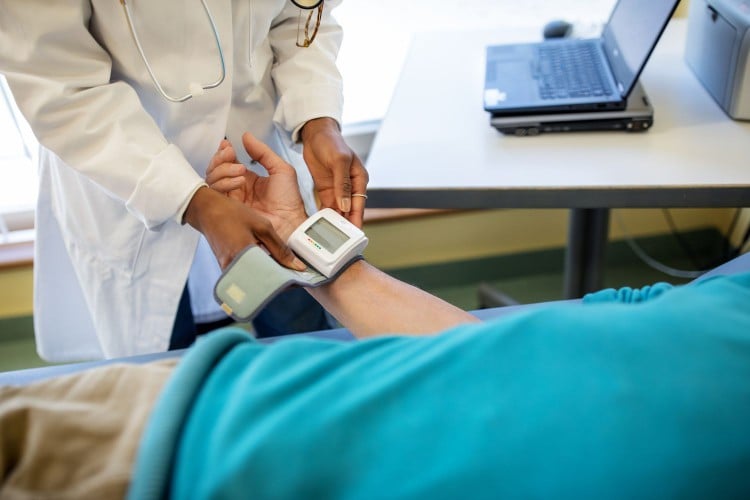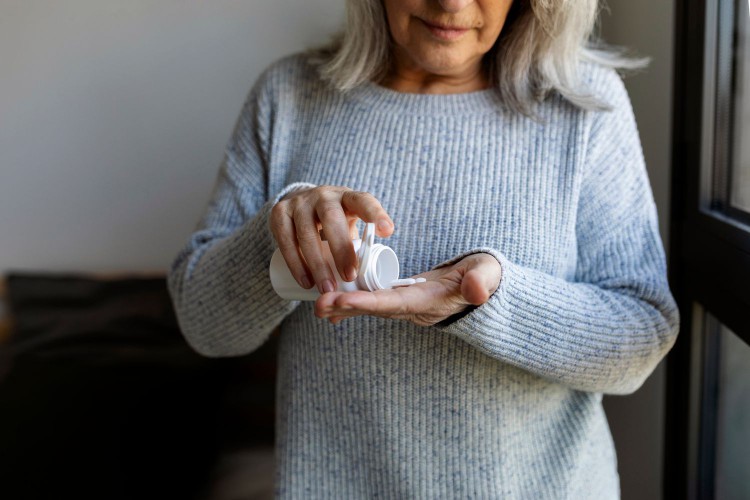Blood Pressure Reading May Differ When Taken Lying Down
- Getting your blood pressure taken while lying down may provide a more accurate reading that could point to cardiovascular risks, new research finds.
- Researchers agree that the gold standard of having blood pressure taken—sitting up—is not wrong, even with the new study’s findings.
- Experts recommend people prioritize understanding their blood pressure numbers and acting on them, as high blood pressure can increase someone’s risk of dangerous cardiovascular events.
Getting your blood pressure taken while you’re lying down may provide more accurate results, new research finds.
There’s a reason you get your blood pressure taken every time you go to the doctor’s office. Blood pressure can often predict certain health severities that are important to take note of—the risk of stroke, heart disease, and even premature death.
That said, it’s important to get the most accurate blood pressure reading for the sake of taking action for your health.
Earlier this month, the American Heart Association (AHA) presented findings regarding how the physical position someone is in while having their blood pressure taken can impact their blood pressure reading, which can in turn impact how well they’re able to predict certain health risks.
It all comes down to from which position an adult receives a high blood pressure reading.
Adults who displayed high blood pressure while sitting upright and lying flat on their backs, had a higher risk of stroke, heart failure, premature death, and heart disease, compared to those who did not have high blood pressure when recorded at either position.
Additionally, adults who had high blood pressure readings while lying on their backs but not sitting upright had similar risks of these same heart health complications who had high blood pressure recorded while both sitting upright and lying down.
Lead study author Duc M. Giao, a researcher and a 4th-year medical student at Harvard Medical School, told Health that he “did not expect supine blood pressure to be such a potent predictor of cardiovascular disease events or for blood pressure to vary so much in the supine position” heading into the research.
So, are doctors doing something wrong by measuring blood pressure while the patient is sitting up versus lying down?
“Physicians measuring blood pressure while patients are sitting upright are not doing anything wrong and that is currently standard practice,” Giao said.
Here’s why your physical position matters to the outcome of a blood pressure reading and whether or not it’s worth requesting to get your blood pressure taken in a different position than normal.

Getty Images / Luis Alvarez
Understanding How Physical Positions Impact Blood Pressure Readings
The data for the new study came from 11,369 adults who were part of the Atherosclerosis Risk in Communities (ARIC) study. Data on the participants’ seated and supine blood pressure were gathered during the study’s enrollment period which took place from 1987 to 1989.
The average participant age was 54, with 56% of participants identifying as female, and 25% identifying as Black. They were followed for 25 to 28 years, with final data collection taking place from 2011 to 2013.
16% of participants who did not have high blood pressure while seated were found to have high blood pressure while lying down. Separately, 74% who had high blood pressure while sitting upright also had high blood pressure while lying flat on their backs.
Those with high blood pressure at both positions showed a 1.6 times higher risk of coronary heart disease, a 1.83 times higher risk of heart failure, 1.86 times higher risk of stroke, a 1.43 times higher risk of premature death, and a 2.18 times higher risk of dying from coronary heart disease.
Additionally, those whose blood pressure readings were high while lying down but not when sitting upright showed similar elevated risks of heart health issues as those whose blood pressure was high in both positions.
According to Giao, a person’s autonomic nervous system regulates blood pressure in various body positions “to provide stability.”
“However, gravity causes blood to pool in the lower extremities when seated and upright,” he said. “If the body is unable to regulate these changes there will be changes in blood pressure between both lying, seated, and standing positions.”
Gregory Katz, MD, a cardiologist at NYU Langone Heart and assistant professor at the Leon H. Charney Division of Cardiology at NYU Grossman School of Medicine, said that it’s important to put studies like this in context.
As in, you shouldn’t be alarmed if you’re getting your blood pressure read while sitting upright during your next annual physical.
Katz explained that anything that raises adrenaline levels will also raise blood pressure. So if someone is stressed or in pain, their blood pressure will rise.
“So, in looking at this study, you have a small number of people who have a discrepancy between blood pressure sitting down versus blood pressure when they are lying [down],” he said.
According to Katz, this could be because there are people who, when their blood pressure is taken, will always be at “elevated cardiovascular risk.”
13 Effective Ways to Lower Your Blood Pressure
Choosing to Get Blood Pressure Taken While Lying Down
According to Giao, people who have elevated blood pressure while in a seated position should consider checking their supine blood pressure, too.
“This could help identify supine hypertension, which is a strong predictor of fatal and nonfatal cardiovascular events,” he said.
Katz reiterated how important it is to put findings from very specific trials like this one in context.
“I think that the message here for patients is that high blood pressure is bad, and identifying that you have high blood pressure is a really important part of cardiovascular intervention,” he said. “But, I hesitate to identify the specific patient or group of patients that need to have their blood pressure taken while lying down.”
Looking ahead, Giao said he and his colleagues will compare supine blood pressure in the clinical setting with blood pressure measurements overnight.
But for now, he said his research suggests that elevated blood pressure measurements “can be detected while supine if measured and could be a useful method of detection of increased cardiovascular risk in the clinic setting.”
He stressed that people with known or suspected cardiovascular risk could consider asking their provider for their supine readings to be checked as well.
While Katz agrees that there is a possibility of different circumstances leading to different blood pressure readings, his main worry is overcomplicating the process for patients.
“I think the more you overcomplicate it the more you are likely to confuse people and to give patients an additional task to do or additional thing to be anxious about,” he said.
At the end of the day, all of this underscores just how important being on top of one’s heart health is.
“Just knowing your numbers is important and high blood pressure is one of the most important numbers to know for people who want to understand their heart disease risk,” Katz said. “Being proactive and having their blood pressure read is something you can do to take control of your health.”
What Is a Healthy Blood Pressure Reading—And How Can You Keep Yours in a Normal Range?










